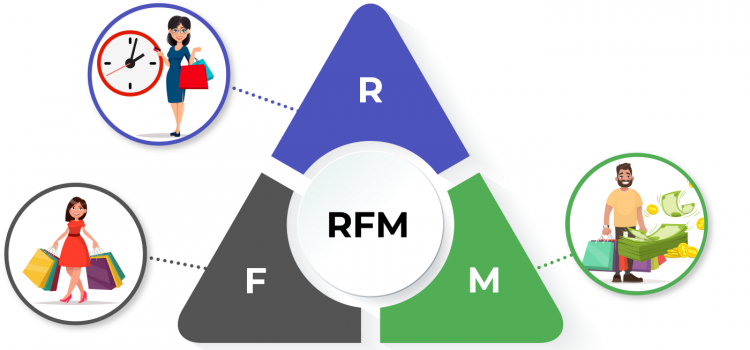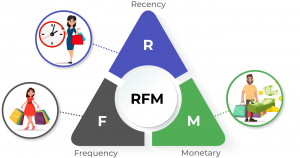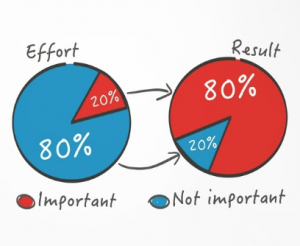In this article we will review RFM analysis at the core of which lie behavioural factors of customers segments. The method of RFM analysis allows you to take a deep insight into customer behaviour, and particularly the behavioral patterns of making payments.
The upshot is that you obtain highly valuable comprehension on building direct marketing for your company. Additionally, RFM segmentation will help you apply a divergent approach to each segment of customers.
1. What is RFM analysis, what is its purpose and business value?
RFM analysis is an analysis method that allows you to segment customers by frequency and amount of purchases and identify those that bring more income.
The RFM abbreviation stands for:
- Recency, meaning a period of time during which your customers bought something from you. A high recency rate implies that the customer already has a good enough impression of your brand to have paid a visit to you recently. You can figure out Recency in the customer base section by sorting customers accordingly to the date of their last purchase.
- Frequency, meaning how often your customers buy from you. A high frequency indicates that the customer likes your brand, your products and services, so he or she often come back to you. To calculate the frequency of purchase, you need to divide the total number of purchases by the number of months/days/years, etc.
- Monetary value, meaning total amount of purchases. A high level of this indicator implies that the client likes to spend money at your shop.
To achieve a reliably accurate RFM analysis, each of these indicators should be conventionally divided into 5 steps – ranging from the smallest number through to the largest one.
Based on these 3 criteria, you can divide all your customers into groups, understand who buys from you often and a lot, who buys little but does it frequently, and who has not bought anything from you for a long time.
RFM analysis eases categorizing your customers into differently-sized segments, so that you can grasp a better understanding of which segments respond best to current ad campaigns and future marketing activities.
Typically, a small percentage of customers respond to generic promotional offers. Whereas RFM analysis and RFM segmentation are excellent methods for customer response prediction, and engagement and profitability improvement. RFM uses customer behavior to determine how to efficiently work with each customer group.
2. Why do you need RFM?
The customer base accumulated over the years makes it possible for us to analyze the needs of the target audience and develop customized offers based on them. It is an important asset for any business.
Retaining a customer and encouraging him or her to repeat purchases breaks the vicious circle, being locked in which you are compelled to make cold sales with the same people every time instead of building a relationship with them once and for life.
Unless you maintain a customer base, you are forced to heavily invest in advertising over and over again. To prevent it, you could have warmed up leads with almost no investment. To do this, it is enough to be able to properly segment the database and develop proposals for each segment; for example, by using RFM analysis, the main perks of which are segmentation clarity and simplicity.
3. Benefits of RFM analysis
Targeting certain mailings to certain groups of customers gives a much higher ad conversion rate than the same non-personalized ads.
At the beginning of each ad campaign, you need to understand which segment of customers this ad will be shown to. After that, you are to create the content that will resonate with the selected audience most strongly. And only then it makes sense to throw all your efforts into launching this campaign. Unfortunately, many of us vainly do exactly the opposite.
RFM analysis simplifies the selection of the target audience for a campaign – it takes into account Recency, Frequency and Monetary Value for each individual customer. On their basis, it molds campaign-ready customer segments. RFM analysis is extremely useful in interpreting your customers’ responses and in building a worthy marketing strategy.
RFM analysis will answer you a wide range of your questions at whim, e.g.:
- Who are my best clients?
- Which of my clients are on the verge of being lost for my business?
- Who out of my clients can potentially be transferred to a more paying segment?
- Who are my lost clients to watch out for?
- Which customers should to be retained by all means?
- Which of my clients is the most loyal to my brand?
- Which customer segment is responding best to current ad campaigns?
4. Superimposing Pareto Principle on RFM analysis
RFM analysis patchily echoes the well-known Pareto’s Principle, which states that 80% of the result comes from 20% of the effort. When this principle is viewed through a marketing lens, 80% of all your sales come from the 20% of your loyal and retaining customers. Long-established clients know no defeat in bringing revenue to a business. Therefore, the return of these clients is mission-critical for maintaining top RFM indicators.
5. RFM analysis’ role in customer retention
No business can make its living without customers, so while new customers acquisition is one of the foundations of a business strategy, retention plays an even greater role in generating strong performance. Customer retention depends on customer satisfaction with your service,or product; on customer support;and on all points of customer’s contact with your brand.
A low loss rate is the easiest approach to expanding your business as this approach is built upon customer satisfaction, and consequently on a good ‘rumour mill’. The RFM model enables a business to create unique promotion funnels for different segments, bringing more value for customers and facilitating loyalty and trust.
What can you do with customer segments in favour of both customer acquisition and retention?
- Customer audit.With the help of RFM analysis segmentation, you can understand what part of your customers are your loyal ones, what part is on the verge of loss, etc. Calculate it, draw sound conclusion and nurture a marketing plan suitable for your customers’ needs.
- Segmented mailings. To increase the effectiveness of your advertising campaigns, send targeted messages to a specific segment of your mailing list. For instance, reactivation for dormant customers, incentive for permanent customers, and etc.
6. Making the best of RFM analysis method
Marketers have been using RFM analysis to optimize the ROI of ad campaigns for decades. Commonly, the use of RFM in advertising is to create a specific creative for a specific segment, and also to segment customers where it is necessary.
“Customer segmentation is not some foreign marketing thing. Large companies try to segment customers as much as possible, and the people behind this have a clearly defined strategy – a strategy for segmenting customers” – Neil Patel
7. How to increase LTV (lifetime value) with the help of RFM
How much do your customers spend throughout the entire period of interaction with your brand? The amount of time depends on a number of factors. RFM analysis has an ability to perfect many aspects of brand-customer interaction: lost customers number reduction, offers to upsell products, customer loyalty increasement and brand promotion through ‘rumour mill’, selling expensive products or services, and many more.
A little warning: don’t overdo. If you interact with one and the same segment too often, customers can get mad and might stop buying from you.
8. RFM analysis as a method of marketing costs reduction and ROI increase
RFM analysis optimizes marketing in business in a holistic way, precisely by:
- increasing customer LTV;
- boosting the launch of new products or services;
- promoting customer experience and their loyalty;
- reducing the number of lost clients;
- increasing the ROI of advertising campaigns;
- making retargeting campaigns more effective and successful;
- helping to understand your business and make analytics more transparent, etc.
Non-targeted ad campaigns tend to cost a pretty penny. By focusing efforts on a smaller audience, you can significantly reduce advertising costs, make it more personalized, and think over creatives and texts based on customer data.
9. RFM for campaigns remarketing / retargeting
Remarketing is an advertising approach when you show an ad to those customers who have been on your site at least once, but show it on completely different websites (including competitors’ sites, and even on Instagram). This ad displaying mechanics boosts the number of clicks and the the campaign’s effectiveness on the whole.
The easiest way to use RFM in remarketing is to export the desired customer segments (for example, recent customers), and later, when you set up Facebook ads for example, to create an audience from these database sheets to whom the ad will be displayed.
In fact, RFM analysis originated from direct marketing. A particular example is reducing the cost of advertising by sending paper catalogs only to those customers who actually use them and order goods.
The same can be applied to digital marketing and any other advertising activity. Segmenting the database before launching advertising and opting for the right target audience reduces the cost of this very advertisement and increases ROI.
What’s it all add up to?
The success of using RFM analysis in marketing has been proven by hundreds of retailers, restaurateurs, beauty business owners and other entrepreneurs.
Checklist for using RFM analysis
- Make your mind you are willing to devote resources to RFM segmentation method. They will be required to regularly check the data, develop strategies for working with each segment, and adjust the strategy to the process.
- Prepare data for RFM analysis. You will need information about every customer: the number of purchases throughout all time, the amount of purchases, as well as the date of the last purchase.
- Distribute all customers by segments. Notably, the number of segments depends on the number of evaluation parameters: e.g. when using the 3 parameters, you will have 27 segments, when using 2 (as in RM, RF and FM analysis) – 9.
- Visualize the segmentation on a graph. You can build it in Excel or Google Spreadsheets, or whatever is convenient for you, using the data in the table. Draw conclusions about the composition of the database.
- Develop marketing activities for each segment. This can be a series of newsletters, or a broader and more complex campaign.
- Analyze campaign results. Make another measurement for possible changes and campaign results comparison (after 1–2 months for large stores, after 3–6 months for smaller ones).
RFM is hardly the only, but exceptionally handy and profitable tool for analyzing the customer base. Having done relatively little tricks and performance with it, you establish a marketing approach that takes into account the individual characteristics of each client.





